
A circa 1884 light fixture used by L. C. Tiffany in his 72nd Street studio and found among the effects of a Sarah Hanley who lived near Laurelton Hall (sold later as Lot # 64, Sale No. 873, Phillips, N.Y., 1987).
I think the work of Louis Comfort Tiffany is like harp music—a welcome pleasure when one happens to hear a bit of it but too mellifluous and gutless for sustained listening. A single, small vase of Lava glass is a strong dose of what makes Tiffany an important artist, whereas dozens of lined-up Favrile vases, stained-glass windows, and leaded lampshades demonstrate that more is only more. Apocryphal stories abound about how out-of-fashion leaded lamps were once upon a time tossed out windows, but thousands of Tiffany lamps survived trashing. Either they never really went out of favor or there were simply too many made for Tiffany’s work to be relegated to the dustbin and forgotten. The world, especially those for whom the world is New York City, loves Tiffany glass. Why shouldn’t they? His lamps have a kind of easy, accessible beauty that would attract even a bowerbird—a precious few of them transcend that base appeal of shiny pretty things to become high Art. Two exhibits in Manhattan indulge animal instinct while leaving the Art quotient to take care of itself. Louis Comfort Tiffany and Laurelton Hall: An Artist’s Country Estate is at The Metropolitan Museum of Art through May 20, and A New Light on Tiffany: Clara Driscoll and the Tiffany Girls is at the New York Historical Society until July 22.
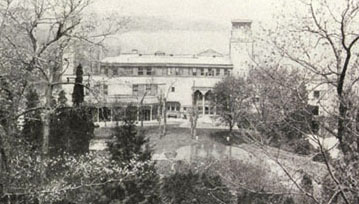
Laurelton Hall was a dream world realized on Long Island in 1905. To my mind, Laurelton Hall, Tiffany’s 1885 New York City residence, and his 1891 interiors for the Henry and Louisine Havemeyer house are the artist’s greatest achievements. Sadly, none survive in their entirety today. The Metropolitan show is based on fragments salvaged from Laurelton Hall, which was destroyed by fire in 1957. The show’s centerpiece is parts of the Daffodil Terrace. It is wonderful that elements of the Terrace survived the fire, but as reconstructed in the museum, they hardly evoke the feeling of this extraordinary house as curator Alice Frelinghuysen seems to intend. I’m not sure what art historical value there is in the expensive installation, although it does have a considerable wow factor and gives the museum an excuse to revisit ravishing old favorites—reason enough, I suppose. Frelinghuysen is related by marriage to Henry and Louisine Havemeyer, and that relationship has informed the way she has integrated Tiffany into the Met’s American Decorative Arts collection during her long tenure as a curator.
Gardenia-like, Laurelton Hall’s sensuality was—and remains—not just heady but overpowering. However, the Met’s exhibition kills that overkill with vast walls of flat paint. Color is the essence of Tiffany’s allure, but the use of jarring, vivid blue-green (peacock?) paint to relate wall color to the work on display—as at the exhibit entrance—quashes one’s own imagination in favor of oxymoronic museum imagination. On display in the adjacent gallery is an early lighting fixture made for Tiffany’s 72nd Street house hung up against an intense red wall—it was found in the Sarah Hanley estate auction. The fixture is counterintuitively lit from the front, turning its rich wine-colored glass into a pasty, rotten-tomato puce. If a sepulchral gray background turns the Daffodil Terrace and the blue-and-white dining room reconstructions into sterile ghosts, the Fountain Court reconstruction goes beyond ghastly toward misrepresentation. I had often wondered if the huge glass bottle Tiffany used as a fountain still existed. In a way it does, but it is no longer the object Tiffany designed. If you are shocked into disbelief by the violent orange-colored surface it now has, you will search for a label and then search the label’s text to find that the color is actually discoloration from oxides in the water that once flowed over the glass. However miraculous the bottle’s survival may be, the piece should not be exhibited as an example of Tiffany’s artistry. As displayed here, the fake pool it sits in—which has fake water made of fabric dyed electric cerulean blue—makes its poster paint color all the more garish.
 |
Even with the artificial tinting added to the period magazine photograph shown on the left, the bottle fountain appears to be made of a very pale, almost colorless glass. As shown at the Met, it has an opaque flourescent orange surface caused by a reaction of chemicals in the water, which flowed over the bottle’s exterior.
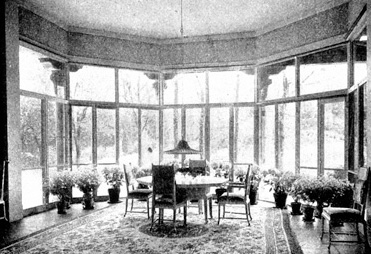 The furniture shown in the Met’s dining room reconstruction is set up on Tiffany-designed rugs. It was used in 1908 as a secondary set placed on a Chinese rug in a bay window off the main dining room. |
The extravagance of this installation gives the impression that the Met is rolling in dough at a time when other museums are feeling a financial pinch. A comparison of the Laurelton Hall exhibit to the New Greek and Roman Galleries brings to mind an age-old museum policy question: Should restoration be obvious to the eye of the beholder?
In the Tiffany exhibit the Daffodil Terrace columns and the stark marble dining room fireplace look like a Crest Whitening Strip disaster; the orange coating was left on the fountain; and fragments of stained glass decorations are shown with flailing, insect-like arms of leading pining for their missing parts. Even in their newly pristine guise, it is obvious that many of the items that actually came out of Laurelton Hall (the majority of the objects exhibited have nothing to do with Laurelton) were plucked from the smoldering ruins.
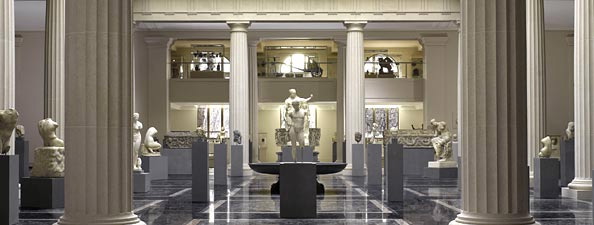
Seriously still, white marble fragments now populate monochromatic galleries where naked boys, birds and flying fish once frolicked through the sparking sprays of water in the “Dorotheum” pool.
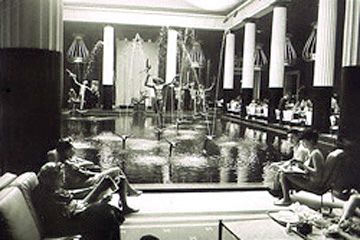
By contrast the ancient vases, gold jewelry, and bronze vessels in the lavish opera-set Greek and Roman installation, which was once a more credible, if space-wasting, Dorothy Draper restaurant, look like they are waiting to be placed on a coffee table in a Peter Marino residential interior. Black and red crockery is all glossy with presumably delicate handles intact. The gold is dreamy, satiny golden and the bronzes and glass have gorgeous patinas worthy of Tiffany. They have no memory of what they looked like when they were made or when they were excavated.
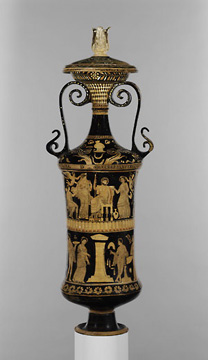

To the casual observer, one Tiffany floriform vase, leaded-glass window, or lampshade may appear to be the same as the next vase, window, or lampshade. However, a connoisseur or collector knows each piece of handmade glass is unique, and the way glass is used in a lamp makes a significant difference in aesthetics and auction dollars. This is true of many glass designers—John La Farge’s Marquand peony window (now in the Met’s collection) or his carp window (now at the Museum of Fine Arts, Boston) would be dull if the glass were not so carefully selected, but each of La Farge’s windows was a unique creation whereas Tiffany made hundreds of wisteria, hydrangea, and water lily lampshades. What makes one hydrangea lamp worth several hundreds of thousands of dollars more than another are the qualities of the opalescent, mottled white glass selected to represent the globular flower heads. The importance of the glass selection process could have been demonstrated by placing a great lamp next to an ordinary lamp of the same design at the New York Historical Society, where there is an exhibit extolling the name of one Tiffany designer, Clara Driscoll.
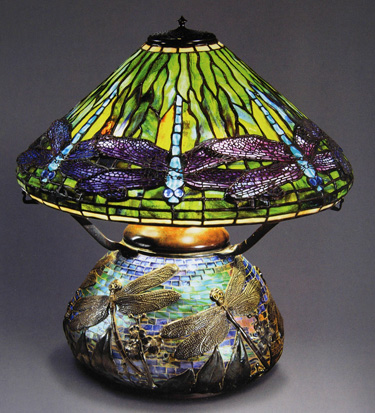
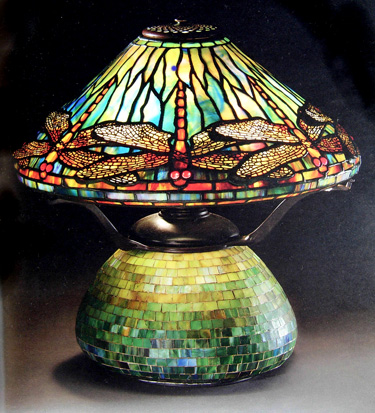
While the dragonflies on the base of the lamp on the left make it incomparably more rare and valuable than the lamp with plain mosaic on the right, the shades are identical in design and they illustrate how radically glass selection can alter the effect.
Martin Eidelberg, cocurator with Margaret Hofer and Nina Grey of A New Light on Tiffany, has been quoted in The New York Times as saying, “I think Tiffany would have died if word had gotten out that Driscoll designed some of his most famous lamps.” Well, Tiffany did die, even though word of his female workforce waited until now to come out, which adds truthiness to the show’s premise that the “Tiffany Girls” were a well-kept secret until Martin, Meg, and Nina exposed them. The breathless tone in both catalogue and exhibit tries hard to make a mountain out of a molehill. Who other than these curators thought Tiffany designed everything bearing his name? Who thinks Calvin Klein, Pierre Cardin, or even megalomaniac Martha Stewart designed all the stuff sporting their imprimatur? Molehills are important because they are molehills—not because they are not mountains.
While listing the gaps and omissions in a trove of Driscoll’s letters, the author of the catalogue’s first chapter (although not attributed, each chapter is written in a different style, so I guess the first is by Eidelberg, the second by Gray, and the third by Hofer) characterizes their importance thus: “Nonetheless, these letters offer the most detailed view inside Tiffany’s firm that has yet come to light. In this regard, they are unsurpassed.” Redundancy is problematic not just in the quote but also throughout the catalogue, where each author explains Edward Booth (a Driscoll husband) as if she hadn’t read the other parts of the book. I appreciate the significance of this “new light,” but it reveals more and less than the authors see.

Surrounding an image of Christ enthroned are from the bottom clockwise: the nativity with wise men, the infant Jesus presented at the temple, a bearded Jesus preaching to the apostles, and the angel at the tomb after the resurrection.
Only two of five scenes in “the rose window with scenes from the Infancy of Christ,” which “may have been one of the first works undertaken by Clara and the Tiffany Girls after the creation of their department,” have anything to do with the baby Jesus. Quibbling? Not if you are relying on observation to discern the difference between Louis Tiffany’s designs and those of the Tiffany Girls. The sophistication of the former is obvious in Laurelton Hall, of which Driscoll herself says, “…you would know at once that it was Mr. Tiffany’s own work.” The consistently lugubrious production of the latter had to appeal to a bourgeois (if rich) clientele. The artistic brio that made Tiffany famous devolved into a branded style. But the authors are not relying solely on subjective observation—they also have Driscoll’s documentation, which leads them to conclude that a whole slew of stylistically different designs are “probably by Clara Driscoll.” “Probably,” “presumably,” “perhaps,” “may have been,” “it seems likely,” and “one can assume” appear too frequently in the catalogue if it is important to establish what women did at the Tiffany firm, particularly when such guesswork is based on modern notions about the past.

An example of firsthand observation clouded by intellectual theory is found in the description of a period photograph of two women and a man in the Tiffany Studios: “An uninspired photograph that Tiffany Studios provided to the Daily Tribune shows two of the Tiffany Girls posed passively, looking idle, while the man (quite probably Joseph Briggs) misleadingly takes an active role as a draftsman.” I am not sure what the “uninspired” qualification means relative to the other period photographs reproduced in the book. While each person in this very grainy reproduction looks quite passive, the only person who is obviously not idle is the woman to the left, who examines or operates some sort of object or tool in her lap. Since the man’s left hand cannot be seen and his right hand (usually the hand used for drawing) is merely holding an image of a face that is identical to the one on the easel, it is misleading to suggest that he is the draftsman. He might well be comparing the likeness of the image in his hands to the image on the easel. If that were the case, the woman on the right might not be passive or idle and could actually be criticizing the man’s work. But multiple interpretations do not spring to a modern mind conditioned by preconceptions about the role of women in the workplace at the end of the 19th century.

|
The mountain of Driscoll material tells much about the Tiffany Girls in particular and less about women who worked with Tiffany in general. Tiffany employed women before Driscoll’s first tenure, which the catalogue dates at 1888. The interior of Tiffany’s 1885 New York City house was filled with custom-designed objects including several leaded-glass lighting fixtures like the one mentioned above found in Sarah Hanley’s estate, which was sold at a Phillips, New York auction. According to Donna Climenhage, curator at the Charles Hosmer Morse Museum (www.morsemuseum.org) in Florida, Hanley was Tiffany’s nurse and later his companion for whom he built a house near Laurelton Hall, which could explain how she came to possess the 1885 light fixture as well as glass fragments, tools, enamels, Tiffany paintings, and countless other artifacts related to Tiffany Studios, but as I remember there were also letters and other documentation suggesting that she worked with Tiffany. Artworks now in the Morse Museum collections indicate that at very least Tiffany and Hanley painted together. The light fixture uses the leading in a way not found in pieces made during Driscoll’s tenure—lead strips are layered to form a dragon and waves. Hanley is not mentioned in the current book perhaps because she was not officially an employee of the company. But the exhibit and catalogue are bound to bring more “girls” out of the closet. Women had a role in the design and production of Tiffany pieces before and after Clara Driscoll oversaw the Tiffany Girls. The extent of that role will have to be explored in a new volume of A New Light. |
